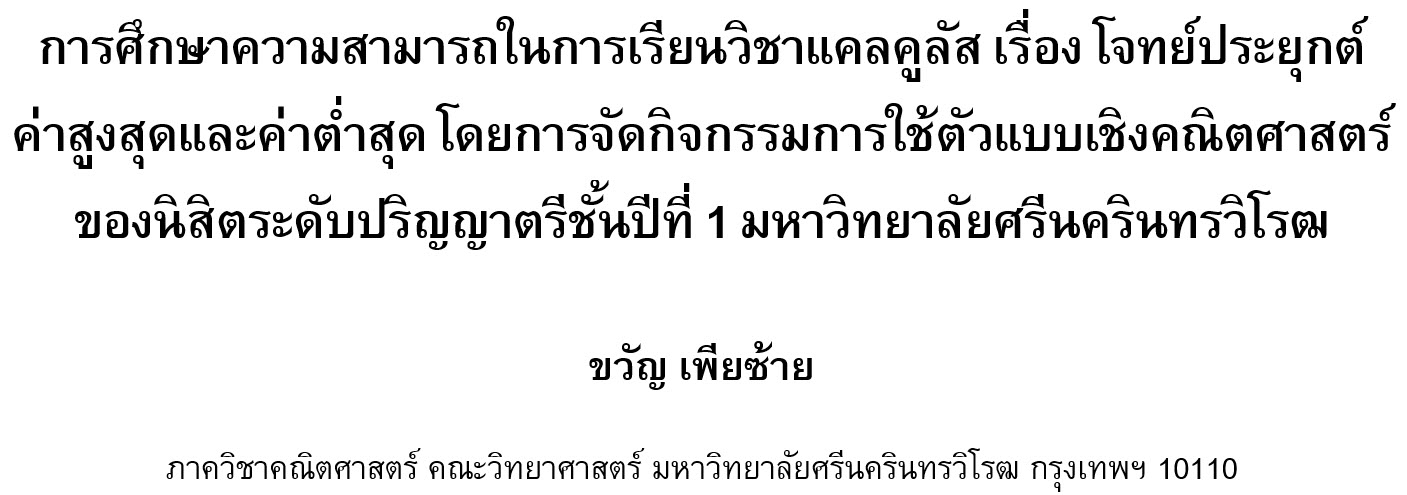การศึกษาความสามารถในการเรียนวิชาแคลคูลัส เรื่อง โจทย์ประยุกต์ค่าสูงสุดและค่าต่ำสุด โดยการจัดกิจกรรมการใช้ตัวแบบเชิงคณิตศาสตร์ของนิสิตระดับปริญญาตรีชั้นปีที่ 1 มหาวิทยาลัยศรีนครินทรวิโรฒ
Main Article Content
Abstract
Khawn Piasai
รับบทความ: 8 มิถุนายน 2560; ยอมรับตีพิมพ์: 30 ตุลาคม 2560
บทคัดย่อ
การวิจัยนี้มีวัตถุประสงค์เพื่อศึกษาความสามารถในการเรียนวิชาแคลคูลัส เรื่อง โจทย์ประยุกต์ค่าสูงสุดและค่าต่ำสุด โดยการจัดกิจกรรมการใช้ตัวแบบเชิงคณิตศาสตร์ของนิสิตระดับปริญญาตรีชั้นปีที่ 1 มหาวิทยาลัยศรีนครินทรวิโรฒ กลุ่มที่ศึกษาเป็นนิสิตระดับปริญญาตรีชั้นปีที่ 1 สาขาวิชาสาธารณสุขศาสตร์ ที่ลงทะเบียนเรียนวิชา คณ 113 (คณิตศาสตร์สำหรับวิทยาศาสตร์สุขภาพ) ภาคเรียนที่ 2 ปีการศึกษา 2558 มหาวิทยาลัยศรีนครินทรวิโรฒ (องครักษ์) จังหวัดนครนายก จำนวน 32 คน โดยการชักตัวอย่างด้วยวิธีสุ่มอย่างง่าย เครื่องมือที่ใช้ในการทดลอง ได้แก่ แผนการจัดการเรียนรู้เรื่อง โจทย์ประยุกต์ค่าสูงสุดและค่าต่ำสุด จำนวน 9 แผน และแบบทดสอบวัดความสามารถในการเรียนวิชาแคลคูลัส เรื่อง โจทย์ประยุกต์ค่าสูงสุดและค่าต่ำสุด ซึ่งเป็นแบบทดสอบอัตนัยจำนวน 4 ข้อ การวิเคราะห์ข้อมูลใช้ค่าร้อยละ ค่าเฉลี่ยเลขคณิต ส่วนเบี่ยงเบนมาตรฐาน และสถิติทดสอบ Z–test ผล การวิจัยพบว่า นิสิตที่เรียนวิชาแคลคูลัส เรื่อง โจทย์ประยุกต์ค่าสูงสุดและค่าต่ำสุด โดยการจัดกิจกรรมการใช้ตัวแบบเชิงคณิตศาสตร์ มีความสามารถในการเรียนวิชาแคลคูลัส เรื่อง โจทย์ประยุกต์ค่าสูงสุดและค่าต่ำสุดผ่านเกณฑ์ มีจำนวนมากกว่าร้อยละ 60 ของจำนวนนิสิตทั้งหมด (p < 0.05)
คำสำคัญ: ตัวแบบเชิงคณิตศาสตร์ แคลคูลัส นิสิตระดับปริญญาตรีชั้นปีที่ 1
Abstract
The purpose of this research was to study students’ abilities to learn a topic of applied maxima and minima problems in a calculus course with mathematical model activities. Using a method of simple random sampling, the participants were 32 first-year undergraduate students who enrolled in a course of MA 113 (Mathematics for Health Science), offered in the second semester of the 2015 academic year, at Srinakharinwirot University (Ongkharak) in Nakhon Nayok province. This study was an experimental research. The subjects learned the topic of applied maxima and minima problems via mathematical model activities created by the researcher. The research tools included 9 action plans of mathematical model activities with applied maxima and minima problems and a 4-item subjective test of students’ learning abilities in the topic of applied maxima and minima problems. The data were analyzed via percentage, mean, standard deviation and a statistical Z–test. The research findings revealed that the number of students who scored higher than lowest test criterion was significantly more than 60% of the total student number (p < 0.05).
Keywords: Mathematical model, Calculus, First-year undergraduate
Downloads
Article Details

This work is licensed under a Creative Commons Attribution-NonCommercial 4.0 International License.
References
Arunphoem, B. (2005). A Study of Achievement in Learning Mathematical Model of Mathayomsuksa VI Students. Master thesis, M.Ed. (Mathematics). Bangkok: Graduate School, Srinakharinwirot University. (in Thai)
Blum, W., and Ferri, R. B. (2009). Mathematical modelling: Can it be taught and learnt? Journal of Mathematical Modelling and Application 1(1): 45–58.
Ernest, P. (1994). Constructing Mathematical Knowledge: Epistemology and Mathematics Education. London: Falmer.
Greefrath, G., and Vorhölter, K. (2016). Teaching and Learning Mathematical Modeling: Approaches and Developments from German Speaking Countries. Switzerland: Springer.
Lanier, S. M. (1999). Students' Understanding of Linear Modeling in a College Mathematical Modeling Course. Retrieved from http://search.proquest.com/docview/304517842.pdf, January 12, 2017.
Muedpa, P. (2013). Promoting the Process of Mathematical Modeling by Using Learning Activities in Pythagoras’ Theorem. Master of Science (Mathematics Education). Ubon Ratchathani: Graduate School, Ubon Ratchathani University. (in Thai)
National Research Council [NRC]. (1989). Everybody Counts: A Report to the Nation on the Future of Mathematics Education. Washington, DC: National Academy.
Panapoi, R. (2015). Desirable characteristics of mathematically. IPST magazine. 44(199): 19–24.
Panmanee, A. (2001). Creative Thinking Development to Excellence. Bangkok: Development Education.
Parsuk, S. (2003). A Study of High School Students’ Ability and Thinking in Working on Mathematical Modeling and Its Effect on Their Attitude Towards Mathematics. Dissertation, Ed.D. (Mathematics Education). Bangkok: Graduate School, Srinakharinwirot University. (in Thai)
Piasai, K. (2014). Error analysis of doing the derivative test of first-year undergraduates (health science major), Srinakharinwirot University. Journal of Research Unit on Science, Technology and Environment for Learning 5(1): 45–56.
Ruangwiset, S. (2006). Mathematics in Every day Life. Bangkok: Idea Square.
The Institute for the Promotion of Teaching Science and Technology [IPST]. (2013). A Guide to Implementation of Upper Secondary Mathematics Curriculum (Revised B.E. 2013). Bangkok: Author. (in Thai)
The Institute for the Promotion of Teaching Science and Technology [IPST]. (2012). Professional Mathematics Teachers: The Path to Success. Bangkok: 3–Q media. (in Thai)
Tian, X., and Xie, J. (2013). Summer camp of mathematical modeling in China. Journal of Mathematics Education at Teachers College 4(2): 39–43.
